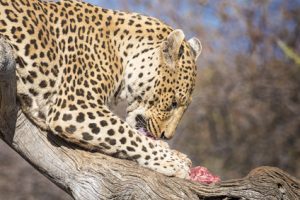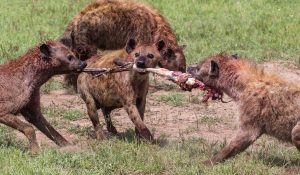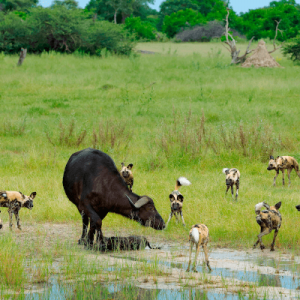African Predators Studies Certificate Level 3
- The African Predators course explores the biology and ecology of the predators found in Africa. Gain an understanding of the role of scavengers and the methods used to survive competition.
Although the most prominent form of predation is possibly the type that is associated with lions killing and eating buffalo, or African wild dogs killing and eating impala (i.e. carnivores eating other animals), it should be remembered that the true definition of a predator is any organism that, kills or inflicts injury on another organism in order to gain sustenance for its own survival. If a predator population was so large, or the prey population was so small or defenceless, predation could quickly reduce or even wipe out the prey population, thereby reducing biodiversity.

Additionally, most predators have predators of their own, or at least competitors, so their population is also kept under control by these interactions. Ultimately the elimination of entire populations of prey animals would have a negative consequence for predators (starvation) as they rely on the ability of prey populations to replenish themselves to ensure future food supplies. In a natural, balanced ecosystem, predator species are outnumbered by prey species and play an important role in moderating community structure.
Weak, ill or young prey animals are often targeted by predators and the removal of these individuals can strengthen the prey population overall. Darwinian evolution indicates that “survival of the fittest” means that only animals that are strong enough to escape or avoid predation will survive to pass on their genes. Therefore, over time, the prey population will be comprised of stronger and stronger individuals. Likewise, selection will favour predators that have the strength and ability to capture enough prey to keep themselves along, long enough to pass on their own genes. Therefore, the predator population will develop in strength, and the “race” between predator and prey adaptation continues. the implications if predators are removed from an ecosystem: Prey populations would become very large, other carnivores that rely on scavenging (eating carrion) would suffer as there would be fewer carcasses left to eat (they would have to wait for animals to die naturally).
Weak or genetically compromised individuals may survive to reproduce – this could reduce the genetic strength of the population. Larger prey populations would lead to overgrazing or over-use of the resource that the prey population relies on for sustenance. Some prey populations may be reduced or wiped out if a single prey population became dominant and out-competed others. Some other predators may lose their prey population if they are specialist hunters and their prey is out-competed by another prey population that this predator cannot consume. Disease may spread more easily and quickly as the prey population grows in size and density.
Only environmental factors would regulate the prey population growth (drought, flood, disease, etc.). All of this could lead to environmental degradation, which would mean the prey population would eventually lose its resource and die out or move away. This course explores the biology, ecology and conservation of african predators.
*You will have access to the course for 6 months only, after which, you can purchase extensions.
Module 1
Biology and Ecology
This African Predators Course module is all about the predators found in Africa; their biology and ecology, with specific emphasis on the methods used to avoid or survive competition.
Module 2
Conservation
This African Predators Course module explores the management and conservation strategies employed for these species.
We offer a selection of accredited and employer recognised courses specifically designed for careers working with animals.
If you have any questions about our courses, please contact us.
We’ve assisted many people to achieve their goal to work with animals. Read more about our 5-star reviews and student success stories.
Gain relevant training to achieve your goal to work with animals.




